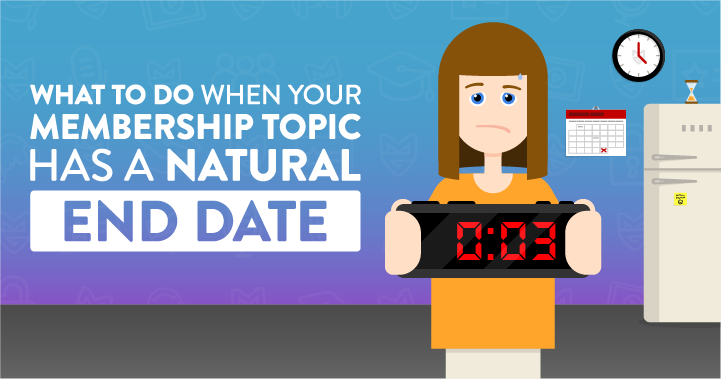What should you do when your membership topic has a natural ‘end date?'
A fixed point when members have achieved what they set out to do and simply don’t need to stay subscribed to your membership.
For example, planning for a wedding or a birth, working towards a qualification or navigating the application process for college…
All of these topics have a very definitive outcome, that once achieved renders your membership redundant.
There are also topics that your members will simply outgrow…
Like a beginners level membership on podcasting, for example, which members will eventually complete and potentially want to move onto the next level.
If your membership topic has a natural ‘end date', you might be banging your head against a wall trying to figure out what you can do to make people stay in your community after they've achieved what they joined to do…
But should you just accept it?
Or do you find ways to adapt your business to prevent members from leaving?
Let’s look at your options…
1. Ask yourself: Do you really need a membership site?
Hold on…
We know what you’re thinking…
Why are The Membership Guys encouraging me to rethink having a membership?
Well as much as we love memberships and think they're awesome (which of course they are)…
They're not the right fit for everyone.

Yes we said it…memberships aren't the best solution for everyone.
And in some cases, another business model might be better suited…
Especially when it comes to these “single use” experiences, where memberships are often not the best approach.
So if your topic has a natural end date, should it be an online course or a membership site?
It's likely that it could make more sense as a paid course or workshop instead…
Because the membership model works best when it’s addressing a recurring need, not a one time need.
So things like passing your driving test tend to work better as a course.
If you’re thinking, “oh no, what do I do now?” don’t worry!
If you decide that the membership route isn’t right for you, you could repurpose the content into a course instead.
The good thing about courses is that you don’t have to worry about things like retention, community management, or ongoing content…
You can simply concentrate on generating sales for your course…
It’s a great “set it and forget it” business model, which works well for some people.
2. Create additional products and services
While your membership topic might have a natural end date, that doesn’t mean you have to say goodbye to your members forever.
You can extend their interest by addressing their needs after they achieved what they set out to do.
Let’s look at the driving test example again…
The work doesn’t stop once they pass the test.
There’s still plenty to learn…
So how can you address that?
Perhaps you can expand the scope of your existing content to keep people engaged…
Can you create additional resources such as workshops, eBooks, or courses to work as new revenue streams alongside your membership?
Maybe you can create a workshop or community for nervous drivers or an ongoing course for practicing hazard perception…
Or even offer them a practical training session on how to check oil or change a tyre.
3. Partner with others
If you don’t meet your member’s needs after they’ve reached the end point in your membership – i.e. passed their test or had their baby – can someone else?
Perhaps you don’t have to create a whole other course or membership to help people get to the next stage…
Maybe you can partner with another business that does that.
Working on a partnership/affiliate basis means you could get a commission for referring members over to them.
This means both you and the member benefit with minimal effort on your part.
4. Accept it for what it is
You could do all of the above to hold onto members…
Or you could just accept it for what it is.

You can accept it for what it is…
If you see that people naturally leave after the six-month mark and you no longer have anything to offer, that’s okay.
It is what it is.
Does that mean you're giving up?
Of course not, but perhaps we should look at this more positively.
Maybe it’s not such a bad thing.
Every membership loses members, regardless of the content.
If you have a natural end date membership, you might see that everyone leaves after six months…
And if your membership didn’t have the fixed leaving point, you might see a bit more variety in cancellations…
Some people will leave after one month, or 10 months or two years.
But you also might still see most people leave after six months anyway…
So, why would you stress about losing members at the six-month mark when that could happen regardless?
Just because someone can stick around forever doesn’t mean they will.
My point is, there will be an average drop off point whether you're addressing one-off or recurring needs…
And while there’s no consensus on the average time someone remains a member, data suggests it’s nine months.
That’s across the whole industry…
This means that many of those memberships that don’t have fixed end dates will still see a drop-off around nine months on average.
So, if your membership has a similar fixed endpoint, is it such a big deal?
No, because it probably wouldn’t be any different if you had a membership where it didn't have those restrictions.
So maybe this isn’t a problem you need to solve or stress over.
The advantages of having a fixed end date
We’d actually go one step further and say that it can be a good thing to have a consistent endpoint for your members…
Knowing that your members will only stick around for nine months is very useful information…
Because it gives you a better idea of your Customer Lifetime Value…
This the metric that all membership sites need to focus on above all else…
So if you have a membership that costs $50 a month, and your members stick around for ten months, your Customer Lifetime Value is $500.
This is the total amount of money you make per member.
Knowing this means you can also better prioritize how much of your time and resource you spend on member retention versus other areas of your business.
You can also use that information to determine ad budgets.
For example, you know you can spend $50 to acquire a member because every member will be worth $500 overall.
Most membership sites have to operate for years and years to get this data.
This means you can stop wasting time trying to improve retention beyond the natural endpoint.
There’s no need to waste time, effort, and resources trying to fix the problem when there isn’t really one.
Don’t try to move an unmovable object!
Instead, invest that time in driving more sales or developing other products.
So if you’ve been losing sleep trying to figure out the solution as to why members keep leaving after a set amount of time, hopefully this article has offered you a solution, some peace of mind and new ideas.
And you're now better equipped to adjust your business model and turn the natural endpoint of your membership topic into a strength rather than a weakness.





